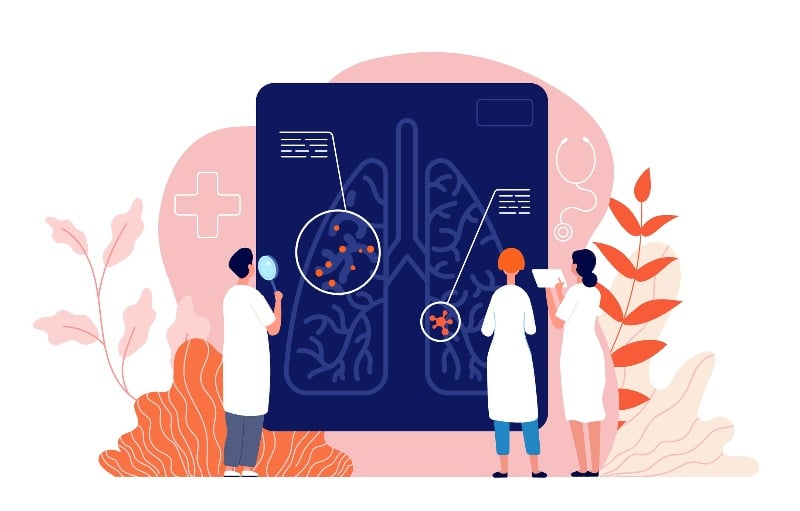June 5 is National Cancer Survivors Day. But unfortunately due to debilitating gaps in care during the pandemic era, there may actually be fewer actual cancer survivors this year than in previous years.
That’s because preventive cancer screenings, particularly in 2020, plummeted during the COVID pandemic. One study identified a 25 percent reduction in the number of cancer diagnoses between 2019 and 2020. That coincided with large numbers of patients avoiding getting screenings and exams due to safety concerns when hospitals and clinics temporarily eliminated their elective procedures.
And it’s not just cancer screenings but all forms of preventive healthcare—from dental hygiene visits to eye health exams—took a nosedive. These gaps in care have led to overall poorer health outcomes for patients and even more serious consequences for people with undiagnosed forms of cancer.
Reduced Cancer Screenings During COVID
Somes studies show that during the most difficult stages of the pandemic, colon cancer screenings dropped 86 percent while testing for breast cancer and cervical cancer decreased 94 percent. Similarly, colonoscopies were down almost 90 percent and prostate cancer screenings were down 70 percent. Overall, colonoscopies in 2020 were down 25 percent.
The most commonly diagnosed cancers in the U.S. are:
- Breast cancer
- Prostate cancer
- Lung cancer
- Skin cancer (melanoma)
- Bladder cancer
The cancers that result in the greatest numbers of death are:
- Lung cancer
- Pancreatic cancer
- Colorectal cancer
- Breast cancer
- Prostate cancer
A JAMA Oncology study published in April 2021 estimated that due to disruptions from COVID, Americans missed more than 9 million screenings for breast, colorectal, and prostate cancers. The study also estimated that the lapse in mammograms and colonoscopies might result in 10,000 more deaths.
Trend of Fewer Screenings Continuing?
Though many of the cancer screening totals have rebounded significantly since 2020-2021, there continues to be lingering effects. One medical expert said that the trend of lower than normal cancer screenings is continuing as older patients especially may have fallen out of the habit. He worries that it may be very difficult for some patients in their 60s-90s to get back in the routine of regular screenings.
The JAMA Oncology study also stated that cancer screening rates have mostly remained below pre-pandemic levels, at least through the first part of 2021. Similarly, it found that screening rates for colorectal cancer had not returned to pre-2020 levels.
These gaps in care are alarming since successful treatment of many forms of cancer relies on early detection through periodic screenings and tests.
Racial Disparities in Reduced Screenings
Another area of concern is that abrupt halting of screenings during the pandemic may have exacerbated existing racial disparities in cancer detection.
When breast and cervical cancer screenings fell by more than 80 percent, the most severe declines were seen in populations of low-income minorities. Similar drop-offs were reported in screenings for colorectal and lung cancer.
The decline in screenings, particularly mammograms, may continue to widen the racial gap in screenings and contribute to increased disparities in cancer mortality rates.
Benefits of Early Cancer Detection
- Improved Patient Outcomes: Early detection of many of the most common forms of cancer can aid successful treatments that lead to increased survival rates. The five-year survival rates for cancer are significantly higher for those diagnosed in earlier stages.
- Lower Healthcare Costs: Early diagnosis can help reduce the cost of treatment. One study estimated the cost savings in the U.S. from early diagnosis at $26 billion annually. Related studies found that the treatment expenses for patients diagnosed in early stages of cancer are 2 to 4 times less costly than those diagnosed at later stages. Thus, early diagnosis can also help reduce the financial burden on the patient with shorter treatment courses.
Value of Pairing a Robust Recall Strategy With Technology
If you’re a healthcare practice that provides cancer screenings, you obviously play a huge role in ensuring that your patients have accessibility to routine screenings they need to support early detection and diagnosis. One best practice to get your patients back in the office for needed cancer screenings is to have a well-planned recall program that identifies each patient’s screening needs and time tables based on their age, gender, previous diagnoses, and other demographics.
This also applies to any healthcare practice or specialty that provides regular preventive care exams or appointments. Your increased ability to help patients receive regular exams and check-ups will help them avoid more serious diagnoses that can be costlier and result in poorer patient outcomes.
But since recall can be a time-consuming activity and a heavy burden on your already short-staffed front office, the most cost-effective approach is to turn to a digital recall tool. Not only can a recall solution ensure that no one gets missed in your outreach efforts to get patients in for screenings and check ups, but its efficiency will save your staff time by getting them off the phones. The top recall tools employ automation so that your staff can effortlessly send notification messages to patients. With the recall tool, staff can set up messages based on a variety of patient criteria such as their age, gender, diagnoses, last appointment date, etc. That way you can automatically send out recall notifications by text, email or voice, based on each patient’s communication preference.
Combining an effective recall program with a feature-filled recall solution can help you reach out to the greatest number of patients more efficiently and effectively. You’ll be able to help ensure patients don’t fall through the cracks but instead have access to timely screenings to avoid late detection of cancers and other diseases that result in poorer health outcomes and lower survivability rates.
At the same time, the blend of strategy and technology will help you:
- Book more screenings
- Reduce manual recall burdens on staff
- Create efficiencies of scale
- Lower operational costs
- Produce an increased recall revenue stream
Don’t leave it to patients to remember when they’re due for that screening, preventive care check-in, or hygiene appointment. Being proactive and looking out for their best healthcare interests is a win-win for both your patients and your practice.
Key Takeaways
Help your patients get out of the care gap cycle that was created during the pandemic. They rely on you to help them remember to receive critical cancer screenings, preventive care, and check-ups to protect their health and help them avoid diseases.
- Reach out with recall notifications to patients who may be overdue for screenings or checkups.
- Ensure your practice has a well-planned out recall strategy and that staff recall activities are calendared, monitored, and measured.
- Implement a digital recall tool to reach more patients more efficiently and effectively to increase response rates and book more appointments.
- A recall solution can be a key component in your recall strategy and help you lower costs, reduce staff manual workload, and increase practice revenue.



